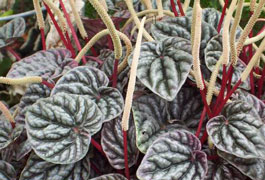


Home
Flowers &
Indoor Plants
Fruits & Nuts
Ornamentals
Vegetables
Special Topics
Resources
Glossary

Emerald-Ripple Peperomia |
 |
What about it? Peperomia is a member of the Pepper family of which there are over 1000 species. Emerald-Ripple is one of the most popular peperomias. It is a small plant, growing only up to 6 inches, due to its short stems. Leaves are 1-15 inches wide and grow in a compact rosette. Their surface is said to look "quilted" and of a glossy green color. The other species of peperomia are: P. argyreia, watermelon peperomia; P. griseoargentea, ivy-leaf peperomia; P. obtusifolia, bluntleaf peperomia; P. orba, and P. rotundifolia. What is it used for? Because of its size, peperomia is ideal for small pots around the home or office, in terrariums, or in dish gardens. Shallow pots will work well. Where does it grow? How do we grow it? Peperomia will grow well in medium sunlight although it will need extra light in the winter. Keep the soil on the dry side and temperatures mildly warm. What are its primary problems? Mealybugs can be a problem with any peperomia. Emerald-ripple will wilt when it becomes too dry. How do we propagate it? The peperomias can be propagated by terminal cuttings, leaf petiole cuttings, or division.
© Copyright, Department of Horticulture, Cornell University. |



